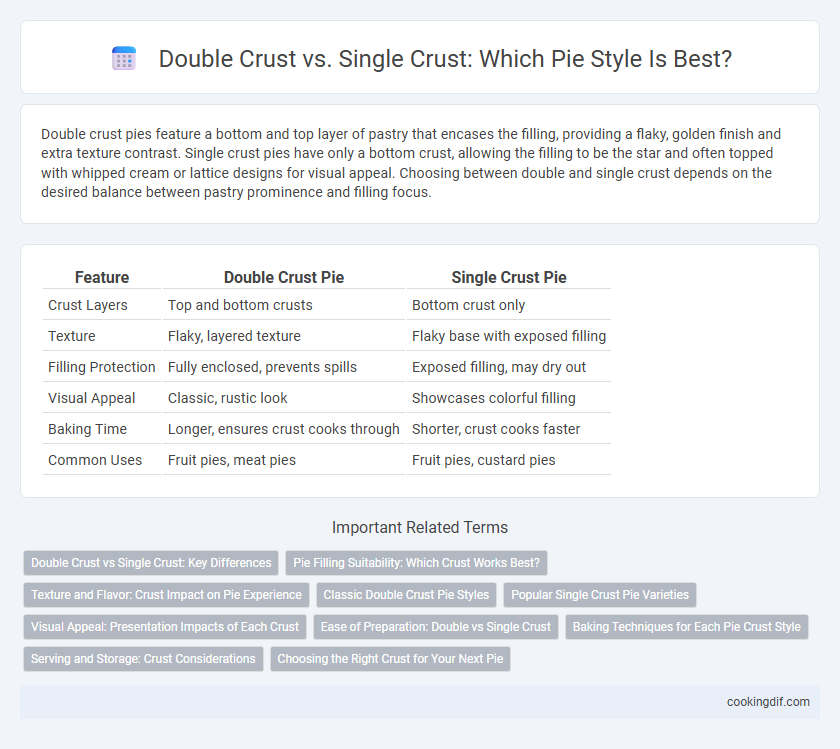Double crust pies feature a bottom and top layer of pastry that encases the filling, providing a flaky, golden finish and extra texture contrast. Single crust pies have only a bottom crust, allowing the filling to be the star and often topped with whipped cream or lattice designs for visual appeal. Choosing between double and single crust depends on the desired balance between pastry prominence and filling focus.
Table of Comparison
| Feature | Double Crust Pie | Single Crust Pie |
|---|---|---|
| Crust Layers | Top and bottom crusts | Bottom crust only |
| Texture | Flaky, layered texture | Flaky base with exposed filling |
| Filling Protection | Fully enclosed, prevents spills | Exposed filling, may dry out |
| Visual Appeal | Classic, rustic look | Showcases colorful filling |
| Baking Time | Longer, ensures crust cooks through | Shorter, crust cooks faster |
| Common Uses | Fruit pies, meat pies | Fruit pies, custard pies |
Double Crust vs Single Crust: Key Differences
Double crust pies feature a bottom and a top layer of pastry, encasing the filling completely, which helps retain moisture and adds a rich, flaky texture. Single crust pies have only a bottom pastry shell, allowing the filling to be exposed, ideal for showcasing fruit toppings or custards. The choice between double and single crust significantly affects the pie's baking time, texture, and flavor balance, with double crusts offering a more sealed, robust bite and single crusts highlighting the filling's freshness.
Pie Filling Suitability: Which Crust Works Best?
Double crust pies are ideal for fruit fillings like apples, cherries, and berries because the top crust locks in moisture and prevents the filling from becoming too watery. Single crust pies suit custard or cream fillings such as pumpkin, lemon, or chocolate, where a crisp, flaky base supports smooth textures without the need for a covering. Choosing the right crust enhances texture and flavor balance, ensuring the filling maintains its intended consistency.
Texture and Flavor: Crust Impact on Pie Experience
Double crust pies provide a rich, flaky texture with added buttery layers that enhance the overall mouthfeel, creating a satisfying contrast between the filling and crust. Single crust pies tend to offer a crisper, lighter base that allows the filling's flavor to take center stage without overwhelming it. The choice between double and single crust significantly influences the pie experience by balancing texture complexity and flavor emphasis.
Classic Double Crust Pie Styles
Classic double crust pies feature both a bottom and a fully enclosed top crust, sealing in fillings like fruit or custard for enhanced moisture retention and rich flavor development. This pie style provides a sturdy structure ideal for juicy fillings such as apple, cherry, or blueberry, preventing sogginess and offering a flaky, buttery contrast between crust and filling. Compared to single crust pies, double crust pies deliver a harmonious balance of textures and protect the filling during baking, creating a traditional, delectable dessert experience.
Popular Single Crust Pie Varieties
Popular single crust pie varieties include fruit pies like apple, cherry, and blueberry, which highlight the fresh filling with a flaky, buttery bottom crust. Pumpkin and custard pies also favor a single crust to provide a sturdy base that complements their creamy textures without overshadowing the smooth filling. Single crust pies emphasize the filling's flavor and texture, making them ideal for simpler, custard-based, or fruit-rich desserts.
Visual Appeal: Presentation Impacts of Each Crust
Double crust pies showcase a golden-brown, sealed top creating an inviting, rustic appearance that signals homemade comfort. Single crust pies emphasize the vibrant, exposed fruit or filling, highlighting color and texture for a more visually dynamic presentation. Pie presentation impacts perception, with double crusts delivering a cozy, traditional look while single crusts enhance the freshness and allure of the filling.
Ease of Preparation: Double vs Single Crust
Single crust pies require less preparation time and fewer ingredients, making them ideal for quick and simple baking. Double crust pies demand extra effort, involving rolling out two layers of dough and sealing the edges to prevent filling leakage. Choosing between double and single crusts largely depends on the desired texture and filling containment, balancing ease of preparation with pie structure.
Baking Techniques for Each Pie Crust Style
Double crust pies require careful sealing of the top and bottom crusts to prevent filling leakage, with venting slits in the top crust to allow steam to escape, ensuring a flaky texture. Single crust pies demand a precise blind baking technique, often using pie weights to avoid a soggy bottom and maintain a crisp, golden base for fillings. Both styles benefit from chilling the dough before baking to enhance flakiness and prevent shrinking during the baking process.
Serving and Storage: Crust Considerations
Double crust pies provide a protective sealing layer that helps retain moisture and flavor during storage, making them ideal for longer refrigeration or freezing periods. Single crust pies usually require airtight containers to prevent the exposed filling from drying out or absorbing odors when stored. When serving, double crust pies offer a balanced texture with both crust and filling, while single crust pies highlight the filling and are easier to reheat without sacrificing crust crispness.
Choosing the Right Crust for Your Next Pie
Double crust pies provide a sealed, fully enclosed filling ideal for juicy fruit or savory pies, preserving moisture and flavor during baking. Single crust pies highlight the filling with a thicker, decorative topping or crumb layer, perfect for custard or cream-based pies where a tender base is essential. Selecting the right crust depends on the pie's filling texture and desired presentation, ensuring optimal taste and structure.
Double crust vs Single crust for pie style Infographic

 cookingdif.com
cookingdif.com